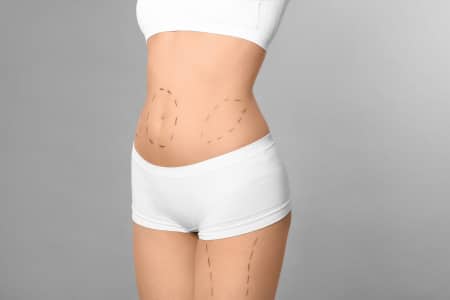Mini Tummy Tuck vs Full Tummy Tuck: Which one is best for you?
Excess tissue on the upper or lower abdomen isn’t always caused by unwanted fat. In fact, in many cases, it is stretched out skin that’s causing a flabby, sagging appearance. When this is the case, your plastic surgeon will likely recommend a tummy tuck procedure.
But what kind of tummy tuck?
You actually have multiple options here. By far, the most common type of tummy tuck is the full tummy tuck. However, there is also another type of tummy tuck that is especially intriguing to many patients because it requires fewer and smaller tummy tuck scars. This is the mini tummy tuck.
If you are considering getting a tummy tuck but are unsure whether to get a mini tummy tuck vs full tummy tuck, this article is for you. Below, we’ll go over what each type of surgery entails and how to determine what the best surgery is for you.
MINI TUMMY TUCK VS FULL TUMMY TUCK
Ultimately, the choice between a mini tummy tuck vs full tummy tuck comes down to what your specific goals and needs are. Every patient is different, so we always want to cater the procedure to the patient.
With that said, there are some clear indications that a mini tummy tuck patients vs a full tummy tuck procedure. For example, the most common reason a patient may need to get a full tummy tuck is if they have loose skin all over the abdomen. And to be sure, this is the most common situation we encounter with tummy tuck patients.
The reason for this is that most patients who are interested in tummy tucks are coming to see a plastic surgeon because they have excess skin due to having children or losing a significant amount of weight. In both of these situations, the patient is going to experience excess, droopy, and sagging skin all over their abdomen.
A situation like this necessitates a full tummy tuck, which can address extra skin above the belly button, below the belly button, and even on the sides of the abdomen. Sometimes, with an extended tummy tuck, for example, the procedure can even address more skin around the back of the abdomen on the flanks — also known as the “love handles”.
Naturally, the reason that patients have excess skin all over their abdomens is because of the way they got the extra skin in the first place. That is, women who get pregnant don’t just see stretching of their bellies on one isolated part of their abdomen. They see stretching all over the belly — from directly below the breasts to right over the pubis.
The same situation can be applied to patients who have lost a significant amount of body fat. Body fat isn’t gained in one isolated place on the middle or upper abdomen. It’s gained all over the abdomen in almost all cases. This means that stretching happens all over the abdomen. And again, when this is the situation, you need a full tummy tuck to address all of that loose skin.
With a mini tummy tuck, on the other hand, we can address an isolated area of excess skin. Usually, this means that the mini tummy tuck is reserved for a patient who comes in with just a little bit of flab on their lower abdomen — below the belly button. Perhaps they lost 10 or 20 pounds and the skin simply didn’t bounce back. This may be common in older patients, for example.
In other cases, aging has simply caused an excess accumulation of skin on the lower portion of the upper abdomen.
When all is said, however, this isolation of excess skin on the lower abdomen is fairly rare. Most of the time excess skin occurs all over. And for this reason, we don’t perform many mini tummy tucks.
WHAT IS THE DIFFERENCE BETWEEN Tummy Tuck Procedures?

First, let’s discuss full tummy tucks. In nearly all cases, full tummy tucks necessitate two incisions. The first incision is going to be the one that most people associate with tummy tuck surgery. It is a lower abdominal transverse incision that runs from one hip to the other.
This will result in a scar. After recovery, however, the scar will not be noticeable because it is so low on the abdomen that it will actually be covered by the patient’s underwear and/or swimsuit bottoms in nearly all cases.
The other incision will be made inside the belly button. This is necessary to cut the abdominal skin away from the naval, and that is done so that we can actually pull down the abdominal skin, stretching it tauter so that it is smoother and flatter.
Doing this is going to change the position of the belly button, so we actually have to make a new hole for the belly button that will be placed over where the naval remains attached to the underlying muscles.
This incision does not leave a noticeable scar either because it is hidden within the belly button.
A mini tummy tuck necessitates only one incision — the same as the first incision we discussed above. It is a lower abdominal transverse incision that may run from hip to hip. However, when it’s a mini tummy tuck, it will usually be shorter — perhaps five or six inches long.
With mini tummy tucks, the belly button incision is not necessary because this surgery does not address excess skin above the naval.
CHOOSING THE BEST TUMMY TUCK Procedure FOR YOU
While the above information will certainly help you discern between a mini tummy tuck vs full tummy tuck, you may still have questions. And by far, the best way to get information and know what type of tummy tuck is right for you is to speak directly with a knowledgeable plastic surgeon who’s performed both of these surgeries before.
Dr. David Sieber a board certified plastic surgeon is the best at fixing abdominal muscles issues in the San Francisco Bay area. If you would like more information about different Tummy Tummy surgery, contact our office today to book a consultation appointment with Dr. Sieber.
REFERENCES
https://www.healthline.com/health/cosmetic-surgery/mini-tummy-tuck#procedure




